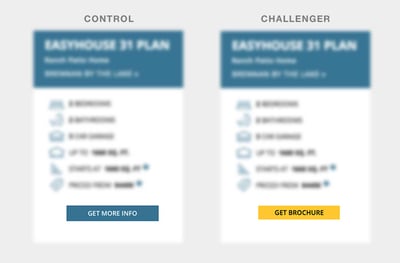Maybe you’ve heard of A/B testing, or split testing, and it sounds like one of those things that you should probably try, but you’re not quite sure what it means or why you’d want to invest in it. In a nutshell, A/B testing is a process of measuring the performance of one version of an element against another. You can test just about anything: changing the words in a call-to-action, moving a form to a different spot on the page, switching out an image, tweaking the copy in a headline, and so on.
So, why is testing a good idea?
 Testing lets you make marketing decisions based on data. This is huge: without data, you’re just relying on intuition to drive your decisions. As much as you might like to think you know what’s best for your customers, or that you can put yourself in their shoes and see it from their point of view, the fact is that it’s not always so easy to predict user perspectives and behaviors. Testing can help remove your own biases from the picture and provide data to confirm or perhaps invalidate what you think you already know about your customers.
Testing lets you make marketing decisions based on data. This is huge: without data, you’re just relying on intuition to drive your decisions. As much as you might like to think you know what’s best for your customers, or that you can put yourself in their shoes and see it from their point of view, the fact is that it’s not always so easy to predict user perspectives and behaviors. Testing can help remove your own biases from the picture and provide data to confirm or perhaps invalidate what you think you already know about your customers.
Testing means better ROI for Marketing
Done right, testing allows you to incrementally optimize your marketing efforts by making small changes, measuring the results, and repeating the process. Collecting data and using that data to optimize your conversion rate (see this article for builder industry average conversion rates) allows you to achieve a higher return on your marketing investments. For example, if you know that a page on your website has been optimized to collect as many leads as possible, you can be confident in starting a new campaign that sends traffic to that page.
Make sure your tests are meaningful
This all sounds great, doesn’t it? Keep in mind that testing isn’t necessarily the best step in your marketing plan right now — we’re definitely not suggesting that you have to immediately start testing every conversion point on your website. Don’t just test for the sake of testing. First, it’s important that you have enough traffic going to your site, and specifically to the pages where you want to run tests. If only a handful of users visit the page during the testing period, and only some of those users convert, the results of your test aren’t likely to be a good representation of overall user patterns. For instance, if your site gets less than 2500 unique visitors per month, you might need to run your test for 6-8 months to get an accurate sample size…and you probably don’t have that kind of time to wait for answers. If your site isn’t getting many visitors, your marketing efforts will be better spent on driving traffic rather than testing.
Assuming you’re good in the traffic department, the next thing to think about is a testing plan. Again, it’s generally not worthwhile to test simply because you can. You need a method of testing a hypothesis, and you need time to let the test run to obtain valid results.
A good example of A/B testing for a home builder web site

Let’s say you have a landing page where you want users to provide their contact information in exchange for a digital brochure of floorplans. It’s currently getting a lot of views but not as many conversions as you’d like. The call-to-action says “Request Brochure” but you have a hunch that “See Floorplans Under $350K” will inspire more potential customers to fill out the form.
You could decide to run an A/B test of this hypothesis by setting up a variant of the landing page with the new call-to-action and sending half of your traffic to each page. After letting the test run long enough to gather meaningful data, perhaps you’d find that your new call-to-action generates 27 percent more conversions. Armed with that knowledge, you’d end the test and move ahead with implementing “See Floorplans Under $350K” because you have concrete evidence that it’s more effective.
Putting it all together
Testing is a powerful tool that doesn’t have to involve big changes all at once but does require some forethought, a calculated approach, and enough time and traffic to accumulate significant data. With those pieces in place, you can leverage tests to gain valuable insights, learn more about your customers, and make incremental improvements to your website, with the confidence that you’re optimizing for higher conversions and a better ROI.
If you’d like to learn more about how the Bokka Group can help you improve conversions (and your customer experience) through A/B testing, just send us a message.


